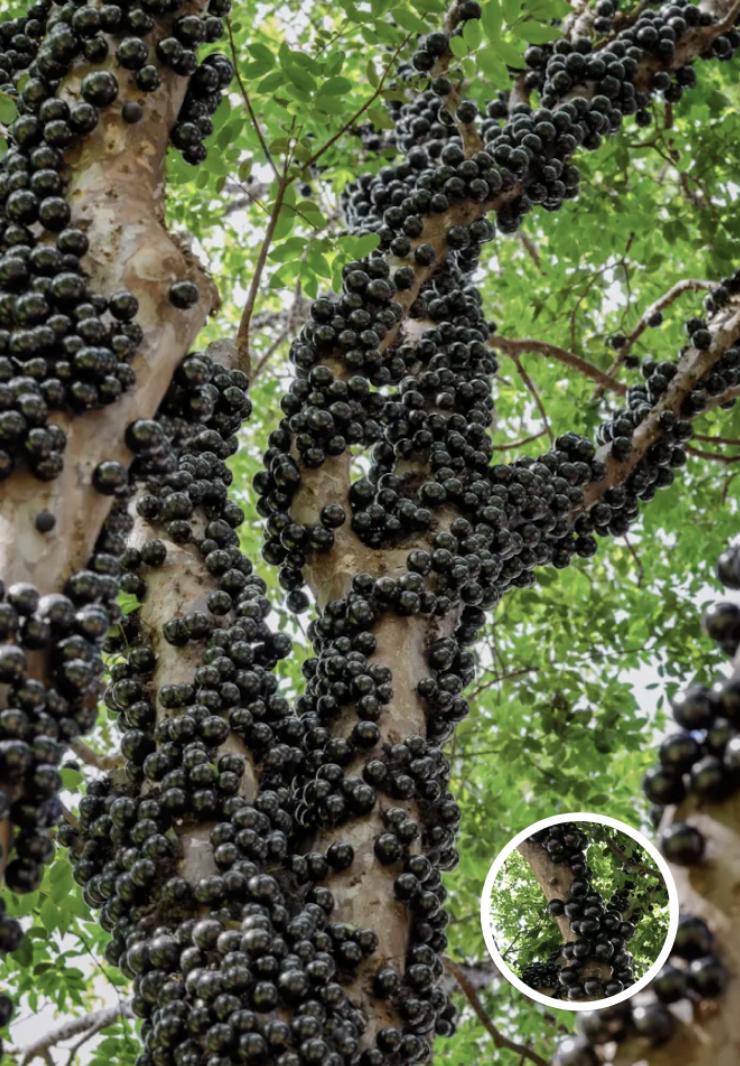A Tree That Looks Too Strange to Be Real
On social media, images of a tree so unusual have gone viral, with many people at first mistaking it for digital artwork. Known as the jabuticaba, or the “Brazilian grape tree,” this South American wonder doesn’t bear fruit on its branches like apple or cherry trees. Instead, it covers its trunk with clusters of dark, grape-like spheres. The sight is so surreal and mesmerizing that it leaves viewers in awe.
Origin and Uniqueness
Belonging to the Myrtaceae family, the jabuticaba is native to Brazil, though related species also grow in Argentina, Paraguay, Bolivia, and Peru. It thrives in warm, humid regions, especially in states such as Rio de Janeiro, São Paulo, and Goiás. What makes it extraordinary is the phenomenon of cauliflory — the growth of fruit directly from the bark of the trunk and main branches. During fruiting season, the entire tree can look as if it’s draped in black-purple pearls.
Appearance and Taste
Though resembling grapes in size and color, jabuticaba fruits are technically berries. Their white pulp is sweet with a subtle tang, making them enjoyable to eat fresh. They are also widely used to make jams, juices, wines, and liqueurs. The tree itself undergoes striking transformations: new leaves are salmon-colored before maturing into deep green, while the fruits ripen from light green to dark purple-black in just 20–25 days. Because they spoil quickly, the berries are best eaten straight off the tree.
Cultural Significance
The word “jabuticaba” comes from the Tupi language, roughly translating to “the place where tortoises are found.” Traditionally, the pale pulp was compared to turtle fat, giving it a cultural link. Beyond its taste, the tree holds sentimental value in Brazil. Families often plant them in their yards, where children grow up climbing the trunks and snacking on the fruit. For many, the jabuticaba is both a source of food and a cherished childhood memory.
A Viral Sensation
Photos and videos of trunks completely covered in berries have captivated audiences worldwide. Comments pour in describing it as “grapes growing out of wood,” while others share nostalgic stories of eating jabuticaba in Brazil. Some even boast of growing the tree in places like Florida or California. Online, the tree has become a sensation — admired, shared, and discussed across platforms.
Nutritional and Medicinal Benefits
Beyond its beauty, jabuticaba is packed with health benefits. Rich in vitamin C, antioxidants, and anti-inflammatory compounds, it has long been used in Brazilian folk medicine to aid digestion, strengthen immunity, and support skin health. Today, scientists are exploring its potential in combating oxidative stress and chronic illnesses, making it not only a local delicacy but also a fruit of global interest.
Cultivation Beyond South America
Because the fruit is so delicate and perishable, jabuticaba is rarely exported, adding to its exotic reputation. Still, enthusiasts around the world have tried growing it, often in greenhouses or tropical-style gardens. While challenging to cultivate outside its native climate, successful harvests in North America have added to its allure among plant lovers.
Why It Captivates Us
The jabuticaba tree is more than a botanical curiosity — it’s proof of nature’s endless ability to surprise us. Its bizarre yet beautiful appearance challenges our expectations of what a fruit tree should look like. Whether admired for its sweet pulp, turned into wine, or simply celebrated online, the jabuticaba remains a symbol of nature’s creativity and wonder.
